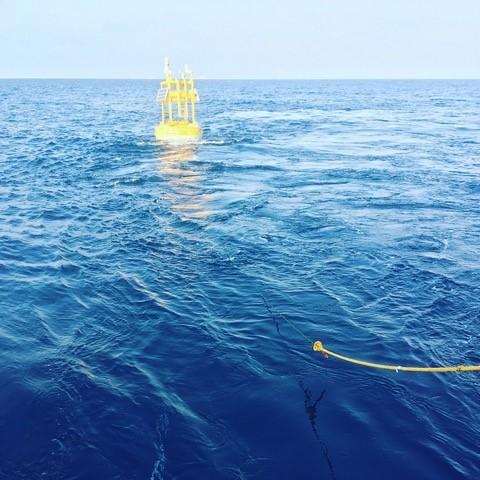Underwater acoustic localization of marine mammals and vehicles

Acquiring experimental data from an underwater acoustic communication system on a boat off the coast of Northern Israel. The depicted buoy belongs to the project THEMO. Credit: @IMDEA Networks Institute Usage Restrictions: Image may only be used with appropriate caption or credit.
Understanding the oceans, which cover two thirds of the Earth's surface and contain information about climate, the history of our planet and yet-to-be-explored energy resources and forms of life, is essential to the future of our planet. Acoustic wireless information transmission through the oceans is one of the technologies enabling the development of future ocean-observation systems, a stepping stone towards gaining a better perception of so many pivotal issues the oceans seem to hold the key to.
This new collaborative research effort has focused on one aspect of information transmission underwater: a simpler, more efficient and less costly system for the localization of sound sources found in the oceans. Nowadays the cost of covering a broad area of the ocean with multiple receivers to locate marine mammals or underwater vehicles based on the acoustic signals they produce is excessively high. Thus, this international team of researchers has set itself the objective of resolving the problem of how to estimate the trajectory of a submerged source that emits acoustic signals without using any anchor nodes or a receiving array.
As conventional localization algorithms such as those used in GPS-like systems cannot be directly ported to an underwater scenario, in this innovative system the localization is performed thanks to the incorporation of additional information about the environment surrounding the receiving hydrophone.
In particular, the system relies on information about the variation of submarine topography, of the depths and shapes of underwater terrain, known in technical terms as “bathymetry”. These variations that are registered along different directions from the receiver induce changes in signal propagation, and these changes are then modeled and used to discriminate the location of the source of the signal. The result, after the calculations have been cleared of residual “noise”, offers a close estimate of the trajectory of the source of sound under examination.
The scientists responsible for this work consider that the location estimations obtained with this system will contain minimum errors provided that the receiver has sufficiently accurate and up-to-date environmental information. The simplicity of implementation and deployment of the innovative underwater localization system designed makes it even possible for applications that have strict size, power and deployment cost limits to achieve localization.
This research, published under the title 'Anchorless Underwater Acoustic Localization', recently received the Best Paper Award at the 14th IEEE Workshop on Positioning, Navigation and Communications (WPNC 2017), which took place in Bremen (Germany) at the end of last October. The IMDEA Networks researchers who have authored it are Dr. Paolo Casari, a Research Assistant Professor, and Elizaveta Dubrovinskaya, a PhD Student under his supervision. Dr. Roee Diamant, in turn, is the head of the Underwater Acoustic & Navigation Lab (ANL) at the Leon H. Charney School of Marine Sciences of University of Haifa.
Media Contact
All latest news from the category: Information Technology
Here you can find a summary of innovations in the fields of information and data processing and up-to-date developments on IT equipment and hardware.
This area covers topics such as IT services, IT architectures, IT management and telecommunications.
Newest articles

First-of-its-kind study uses remote sensing to monitor plastic debris in rivers and lakes
Remote sensing creates a cost-effective solution to monitoring plastic pollution. A first-of-its-kind study from researchers at the University of Minnesota Twin Cities shows how remote sensing can help monitor and…

Laser-based artificial neuron mimics nerve cell functions at lightning speed
With a processing speed a billion times faster than nature, chip-based laser neuron could help advance AI tasks such as pattern recognition and sequence prediction. Researchers have developed a laser-based…

Optimising the processing of plastic waste
Just one look in the yellow bin reveals a colourful jumble of different types of plastic. However, the purer and more uniform plastic waste is, the easier it is to…



